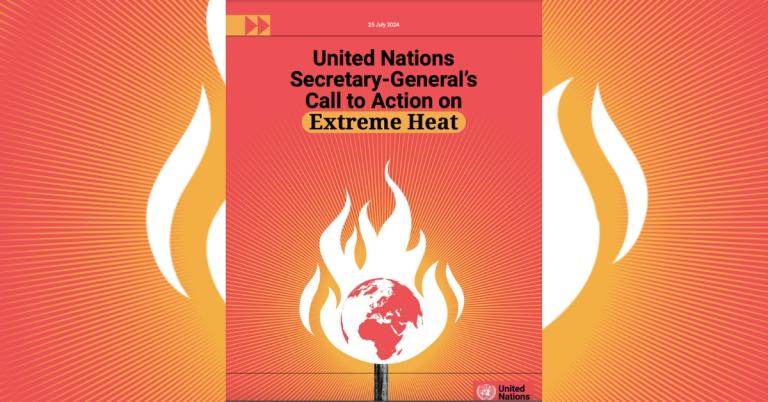The first anniversary of the UN Secretary-General's Call to Action on Extreme Heat on 25 July coincides with intense heatwaves which are impacting many countries around the world, underlining the importance of early warnings and heat-health action plans.
To mark the anniversary, the Global Heat Health Information Network (GHHIN), together with the World Meteorological Organization and the UN Office for Disaster Risk Reduction, is launching new resources through their joint initiative Supporting Extreme Heat Risk Governance to strengthen coordination on heat risk reduction, helping countries and communities better prepare for rising temperatures.
The need for action is evident on a daily basis.
A silent killer
As of 24 July, nearly 100 million Americans are under heat-related warnings and advisories, including for "dangerous" heat.
Extreme heat is also gripping much of North Africa and the Middle East, with Iran reporting severe disruptions to electricity and water supplies.
The Mediterranean region and the Balkans are enduring the third heatwave of the summer. This has prompted the closure of popular tourist attractions, disrupted outdoor and agricultural and labour activities, and had a major impact on health. It has also fuelled wildfires, which have caused casualties and worsened air quality.
Europe had its hottest June on record. Major heatwaves - intensified by high sea surface temperatures in the western Mediterranean Sea - led to 'very strong heat stress' in large parts of western and southern Europe.
At global level, it was the third warmest June on record, according to the US National Oceanic and Atmospheric Administration and the EU's Copernicus Climate Change Service .
"Extreme heat is sometimes called the silent killer, but with today's science, data and technologies, silence is no longer an excuse. Every single death from extreme heat is preventable," said WMO Deputy Secretary-General Ko Barrett.
Modelled estimates show that between 2000 and 2019, approximately 489,000 heat-related deaths occurred each year, with 45 per cent of these in Asia and 36 per cent in Europe. Worldwide, the official diagnosis and reporting of heat-related illness, injuries and deaths are recognized to be under-reported.
Most attribution studies show a clear link between extreme heat and climate change caused by heat-trapping greenhouse gases.
WMO Response

WMO is one of ten specialized United Nations entities rallying behind the UN Secretary-General's Call to Action on Extreme Heat.
This seeks to enhance international cooperation to to minimize heat impacts through targeted economic and social policies and concrete actions, including public awareness campaigns. There are four critical areas:
· Caring for the vulnerable
· Protecting workers
· Boosting resilience of economies and societies using data and science
· Limiting temperature rise to 1.5°C
In response to the Call to Action, WMO and its Members are working to bolster heat early warning systems in line with the Early Warnings for All initiative . This aims to ensure at-risk populations receive timely alerts that include information on protective actions to undertake and sources of assistance.
According to estimates produced by the WHO and WMO that the global scale-up of heat health-warning systems for 57 countries alone has the potential to save an estimated 98,314 lives per year.
"Extreme heat is no longer a distant or seasonal concern-it's a daily reality for millions." said Joy Shumake-Guillemot , lead of the WHO-WMO Climate and Health Joint Programme and co-lead of the Global Heat-Health Information Network (GHINN).
"Our Network is connecting science, policy, and action so that no community is left behind in the race to adapt to climate change that will continue to worsen extreme heat for years to come. This is not just a climate issue, it's a public health emergency," she said.
The work of the Joint Climate and Health Office has been boosted by a partnership with the Rockefeller Foundation and Wellcome, which have jointly mobilized U.S. $11.5 million. There is a particular focus on extreme heat.
Supporting extreme heat risk governance
The new resources launched by GHINN, UNDRR and WMO include:
· Stocktake Report: Heat action across United Nations Entities and International Organizations
This report examines the landscape of extreme heat management among for the first time, identifying challenges, opportunities, and strategies for improving collaboration and governance to support the United Nations Secretary-General's Call to Action on Extreme Heat.
· An Assessment of Heat Action Plans: Global standards, good practices and partnerships
This synthesis report identifies best practices and persistent challenges to provide a structured framework for improving heat resilience based on evaluations of heat action plans from six countries: Australia, Canada, France, India, the United Kingdom, and the United States.
· Narrative Analysis: Case studies in heat resilience
This narrative analysis highlights how 12 countries are confronting the realities of extreme heat through diverse governance models, partnerships, and innovations. The case studies span multiple regions and development contexts-Argentina, Australia, Bangladesh, Canada, Ecuador, Egypt, France, India, Senegal, the Republic of Korea, the United Kingdom, and the United States, offering a cross-cutting view of what is working, where gaps remain, and how national strategies are evolving in the face of escalating climate threats.






